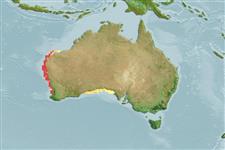>
Blenniiformes (Blennies) >
Blenniidae (Combtooth blennies) > Salariinae
Etymology: Cirripectes: Latin, cirrus = curl fringe + Greek, pektos, -e, -on = made of several parts solidly united (Ref. 45335); hutchinsi: Named for Barry Hutchins of the Western Australian Museum..
Environment: milieu / climate zone / depth range / distribution range
Ekologi
laut berasosiasi dengan karang; kisaran kedalaman 1 - 22 m (Ref. 529). Subtropical; 20°S - 33°S
Eastern Indian Ocean: known only from Western Australia (North West Cape southward to Rottnest Island).
Length at first maturity / Size / Weight / umur
Maturity: Lm ?, range 7 - ? cm
Max length : 10.6 cm SL jantan/; (Ref. 529)
deskripsi pendek
Morfologi | Morfometrik
Duri punggung (Keseluruhan (total)): 12 - 13; duri punggung lunak (Keseluruhan (total)): 13-14; Duri dubur 2; Sirip dubur lunak: 15 - 16; vertebrata, bertulang belakang: 30 - 31. Diagnosis: Dorsal fin XII, 14, membrane attached to caudal fin, with deep notch above last spine, first spine almost same or slightly higher than second; anal fin II, 15; pectoral rays 15; pelvic fin I, 4; caudal fin procurrent rays 11-14. Vertebrae 10 + 20-21. LL, without scales and scalelike flaps; LL tubes 3-9 (usually 8-13), canal ends below posterior to 13h dorsal ray, usually on caudal-fin base. Upper lip crenulae 36-42. Gill rakers 23-29. Cephalic sensory pore system complex. Cirri, nuchal 35-42, nasal 8-93, supraorbital 12-29; 4 groups of nuchal cirri, each ventralmost group borne on slightly expanded nuchal flap. No pores at extra interorbital pore position. Geographic variation in color pattern exists in females; 2 color patterns in male may exist in the same geographic area; background color brown; yellow to orange iris (Ref. 529).
Facultative air-breathing in the genus (Ref. 126274); Found in the surge zone in limestone holes just below the intertidal range. Common in areas where Pocillopora damicornis is present on the reefs (Ref. 529). Oviparous. Eggs are demersal and adhesive (Ref. 205), and are attached to the substrate via a filamentous, adhesive pad or pedestal (Ref. 94114). Larvae are planktonic, often found in shallow, coastal waters (Ref. 94114).
Oviparous, distinct pairing (Ref. 205). Urogenital orifice of male genital papilla located basally between 2 widely separated slender filaments on a fleshy swelling behind anus; testes bulbous with length equal to its width (Ref. 529).
Williams, J.T., 1988. Revision and phylogenetic relationships of the blenniid fish genus Cirripectes. Indo-Pac. Fish. (17):78 p. (Ref. 529)
Status IUCN Red List (Ref. 130435)
ancaman kepada manusia
Harmless
penggunaan manusia
Perikanan: tidak ada kepentingan
informasi lanjut
Umur / SaizPertumbuhanpanjang-beratpanjang-panjangukuran frekuensiMorfometrikMorfologiLarvaDinamika larvapemulihanKelimpahanBRUVS
AcuanBudidaya airprofil budidaya airStrainGenetikaElectrophoresesDiturunkanPenyakit-penyakitPengolahanNutrientsMass conversion
mitraGambarStamps, Coins Misc.Suara-suaraCiguateraKecepatanTipe renangArea insangOtolithsOtakPenglihatan / visi
Alat, peralatan
laporan khas
muat turun XML
Sumber internet
Estimates based on models
Preferred temperature (Ref.
123201): 18.1 - 26.7, mean 22.2 °C (based on 115 cells).
Phylogenetic diversity index (Ref.
82804): PD
50 = 0.5000 [Uniqueness, from 0.5 = low to 2.0 = high].
Bayesian length-weight: a=0.01072 (0.00480 - 0.02393), b=3.01 (2.82 - 3.20), in cm total length, based on LWR estimates for this (Sub)family-body shape (Ref.
93245).
Trophic level (Ref.
69278): 2.0 ±0.00 se; based on food items.
Daya lenting (Ref.
120179): Tinggi, Waktu penggandaan populasi minimum kurang dari 15 bulan (Preliminary K or Fecundity.).
Fishing Vulnerability (Ref.
59153): Low vulnerability (10 of 100).
Nutrients (Ref.
124155): Calcium = 79.9 [29.7, 158.9] mg/100g; Iron = 0.851 [0.471, 1.527] mg/100g; Protein = 19 [18, 20] %; Omega3 = 0.202 [0.108, 0.368] g/100g; Selenium = 10.3 [4.7, 23.1] μg/100g; VitaminA = 75.6 [20.1, 285.3] μg/100g; Zinc = 1.67 [1.04, 2.65] mg/100g (wet weight);
